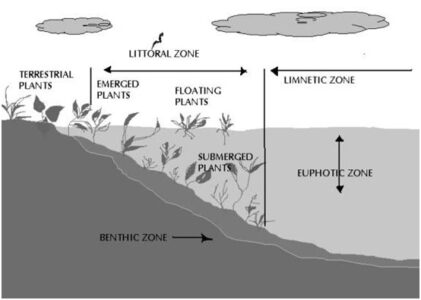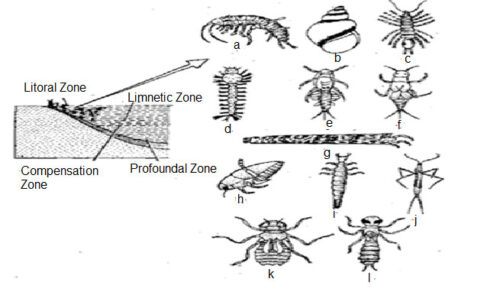Pond is a small body of stagnant water which is smaller than a lake. Ponds can be either nature-created or man-made. The marsh, aquatic plants and various aquatic animals live mainly in the pond water. Various animals depends on the water level of the pond, food level, presence of plants, presence of harmful animals, confirmation of light, level of salinity etc. Depending on the depth of the water, sunlight can penetrate to the bottom of most ponds.
The water level in ponds increases with increase the river water level which is noticeable during floods. In some cases, pond water is not stored or preserved all the year round. Such ponds are known as spring ponds, temporary ponds, seasonal ponds or temporary wetlands. Usually there are no fish in such ponds. Locally, especially in the rural areas of Bangladesh, ponds are more or less called as puskarini. Since the water in the pond is stagnant, it is relatively hotter than the river water. Such stagnant water plays a vital role in many eco-friendly flora and fauna.
The bottom of the pond is covered with silt and fish and frog larvae are stored in the roots and holes of trees growing on the banks of the pond. The deep bottom is low in oxygen. Only the animals concerned can stay in the cool environment of that bottom. Plankton can extend their life to all levels of water. Man-made ponds are usually quadrangular in shape. One of the main features of the pond is the constant presence of water. This results in a favorable living environment for the aquatic flora and fauna.
According to Welch, a pond is a very small shallow stagnant body of water with calm water and a large number of aquatic plants. According to Odum (1970) ponds are small aquifers with a relatively large littoral area. The lymphatic or profundal region is small or absent.
Classification of Pond
There are two types of ponds based on seasonal stability, namely: permanent ponds and temporary ponds.
Permanent pond: This type of pond has water all the year round.
Temporary ponds: These ponds have water in some seasons of the year and dry at other times. There are three types of temporary ponds in temperate regions.
(1) Spring pond: This type of pond has water only in spring.
(2) Autumn ponds: Such ponds dry up in summer and are full of water in autumn.
(3) Summer pond: There is water all the year round but in winter ice accumulates at the bottom.
Welch (Welch, 1952) divided the pond into the following categories:
(1) Creation of a pond through the elimination of a lake whose bottom (basin) is never as big and deep as a lake.
(2) Creation of lakes as a result of human activities (excavation, artificial lakes, etc.).
When small rivers change their course in a natural process, ponds are formed through them. In areas rich in limestone in the soil, the accumulation of water in the holes created by the process of submergence can lead to the formation of ponds in a natural way.
Ecological Zonation of Lakes and Ponds
Aquatic habitats of lakes and ponds can be vertically divided into different levels based on light penetration, wavelength absorption, surface pressure, temperature, etc., viz.
(1) Littoral Zone
The shallow area where light enters the bottom is included in this region. Natural ponds and lakes have rooted plants. However, in the case of cultivation ponds, such plants may not exist. It has a layer of hot and oxygen rich water on top which is called epilimnion.
(2) Sublittoral Zone
After the evacuation of rooted vegetation region, there is a layer of cold water with less oxygen flowing which is called hypolimnion.
(3) Limnetic Zone
The limnetic zone is the open area away from the shore. The region extends as far as light effectively penetrates and to a depth where the rate of photosynthesis and respiration are equal.

Lake Zones
(4) Profundal Zone
This area is located below the lymphatic region, the area of deep water and below the area of effective light penetration.
(4) Abyssal Zone
It is observed only in deep lakes. The region starts after a depth of 2000 meters from the surface. In the case of ponds, a small amount of vertical stratification is observed. In this case, the littoral region tends to be larger than the lymphatic and profundal regions. In the case of small ponds, the lymphatic and profundal regions are not observed.

Figure: Extension of some benthos in the littoral region of lakes and ponds: – (a) Amphipod; (b) Snail; (c) Isopod; (d) Mosquito larvae; (e) and (f) May fly nymph; (H) Mature Disticus sp (i) Larvae of Disticus sp; (j) Ranatra sp; (k) and (l) Nymphs of Dragon Fly
The main difference between lakes and ponds is that the limnetic and profound regions of the lake are larger than the littoral regions. Moreover, lakes can be divided into trophogenic zones (sublittoral with littoral) and tropholytic zones (upper zones of the profundal region) based on the penetration of light and the ability to photosynthesize. The trophogenic region has a large number of plants and plant-dependent fauna. However, in the tropholytic region there is an absence of aquatic plants and in most cases, there are dead animals. These two regions have fish compensation areas. The rate of respiration and photosynthesis are equal at this boundary.
